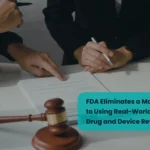FDA Recalls for Medical Devices: Classes, Process & Compliance Strategy
Medical device manufacturers have a huge responsibility to ensure the safety and effectiveness of their medical devices, especially once the products are on the market. This is why if any problem occurs in the device, the companies need to take quick action, work on a solution to rectify the issue, and identify if the FDA recalls is required or not.
Elexes has guided over 50 successful FDA recall responses across Class I, II, and III products, including field corrections and 806 reporting. If you’re leading quality or regulatory at a MedTech company, here’s what you need to know about the FDA recall process.
In this blog, we are going to take you through what is a recall, the types of recall, the classification of recall, the entire FDA recall process, and the important timelines involved in a recall.
What Is a Medical Device Recall?
When a medical device manufacturer identifies any problem with the medical device, they propose a correction or removal, depending on where the action takes place.
Correction – If the problem with a medical device is addressed in the place where it is sold or used.
Removal – If the problem with the medical device is addressed by removing it from where it is being used or sold.
The FDA used the term “recall” in both correction and removal actions taken by medical device manufacturers. Usually, these FDA recalls occur when a medical device is defective, poses a health risk, or both.
What Are The Different Types of FDA Recalls?
There are 2 different types of recalls – Voluntary and Nonvoluntary.
Voluntary Recalls
21 CFR Part 7
This is when the manufacturer or distributor initiates recall by themselves when they learn about the violations, defects, or issues with their device. If this happens, the company needs to –
First, initiate a recall (either through correction or removal).
Second, notify the FDA.
Nonvoluntary Recalls
21 CFR 810
In case, the manufacturer fails to voluntarily recall the device that poses a risk to patients’/consumers’ safety or health, the FDA may issue a recall order under 21 CFR 810, Medical Device Recall Authority. Although this type of recall exists, it is still very rare.
FDA Recall Classifications Based on Risk
Class 1: These are the situations where the device/product poses serious health issues or death, making this the most serious of all recall classes.
Class 2: These are the recall situations where the medical device poses temporary or reversible health risks and has a slight chance of causing serious problems or death.
Class 3: These are the recalls where the product is not causing any serious health problems but violates a law or regulation enforced by the FDA.
What is the FDA’s involvement with medical device recalls?
Although most of the regulatory processes are overseen by the FDA, Recalls usually begin on the manufacturer’s side. Unlike what the term portrays, recalls don’t mean immediate removal of the medical device in question, they can take the form of a variety of corrections like:
➺ Inspection
➺ Calibration
➺ Basic repair
➺ New Labeling
➺ Performing additional tests
➺ Notifying patients
Why Does the FDA Use Recalls?
The FDA uses recalls as they are the most effective means to remove or correct FDA-regulated products from the marketplace which requires speed to ensure patient safety.
When to Report?
It is mandatory to submit the report within 10 working days from the time the company initiated the correction or removal action. In cases where there is no “risk to health” involved, a report is not required to be submitted but manufacturers or importers need to keep a record of the correction or removal action they took.
Who is Required to Report?
Usually, it is the responsibility of the manufacturers or importers to report recalls. Only the one who has initiated the correction or removal action is required to report it.
Manufacturers (807.20 (A))
A manufacturer is the one who designs, manufactures, fabricates, assembles, or processes the medical device. This also includes someone who performs labeling or relabeling, packaging or repackaging. A Manufacturer may or may not be in the US.
Importers (807.40 (A))
An importer is the one who furthers the marketing of the device. He is the one who brings the product from a foreign manufacturer to the person who makes the final delivery or sale to the consumer or user. Remember, the importer cannot change the container, wrapper, or labeling of the product. An importer must have a US physical address to ensure the compliance of imported devices.
FDA Recall process
You can report corrections or removals in two ways – by electronic submission (eSubmitter) or via email.
Let’s discuss each one of these methods one by one –
eSubmitter
In this method, the reporter has to submit the report using the eSubmitter software (eSubmitter Download and Installation | FDA) Once the report is created, it is sent to the Center for Device and Radiological Health (CDRH) through the FDA Electronic Submission Gateway (ESG).
Note: FDA encourages the use of eSubmitter.
Another way of reporting a recall is by emailing the report to the FDA’s Office of Regulatory Affairs (ORA) Division Recall Coordinator (DRC). These coordinators are listed by state or region.
Note: Foreign manufacturers and importers are required to email DRC where their US agent is present.
Now that we have understood the process of reporting FDA Recall, it is time to understand what information is required to be in the report.
What information is required?
There are several things that you must include in the report –
➺ Requirements as per 21 CFR 806.10(C)
➺ Strategy for recall
➺ Recall letters to direct accounts
➺ Time frame
➺ Status report information
Let’s elaborate on each of these requirements –
Requirements as per 21 CFR 806.10(C)
✓ Registration number, date the report is made, sequence number (001, 002, etc.), “C” for correction or “R” for removal
✓ The report should include the name, phone number, address, and contact person of the firm who is given the responsibility for conducting the correction or removal
✓ Brand name and common name of the device and its intended use
✓ It should also include the device listing number and FDA marketing status (i.e., 510(k), PMA, preamendment status)
✓ Model/catalog number, lot/serial number
✓ Manufacturer’s contact information (name, address, phone number, contact person) if different from the second item above
✓ You should also describe the event or events along with the corrective as well as removal actions that have already been taken and that are expected to be taken.
✓ List if there has occurred any illnesses or injuries with the use of the device. If applicable, you must also include the Medical Device Report (MDR) numbers submitted under 21 CFR 803.
✓ How many devices are subject to the correction or removal
✓ Dates of when the device was manufactured and distributed. Along with that you also need to mention the expiration date or expected life
✓ Name, address, and phone number of all consignees (domestic and foreign), and the dates and number of devices distributed to each consignee
✓ You must attach a copy of all communications related to the correction or removal action taken
✓ A statement as to why any required information is not available and a date when it will be submitted (if this has not been done already)
Strategy for recall
You need to ensure that you include these 3 elements and elaborate on each of these – Depth of Recall, Public Warning, and Effectiveness Checks.
Recall letters to direct accounts
Recall letters are an important document needed for the recall and should be done with precision. When you are preparing a recall letter for your device, you need to ensure that you stick to the point and make it as brief as possible.
Here are a few points to consider while writing a recall letter.
✓ Identify the product, size, lot number(s), code(s) or serial number(s), and any other pertinent descriptive information to enable accurate and immediate identification of the product.
✓ Explain concisely the reason for the recall and the hazard involved, if any.
✓ Provide specific instructions on what should be done concerning the recalled products.
✓ Provide a ready means for the recipient to report to the recalling firm whether it has any of the product, e.g., by sending a postage-paid, self-addressed postcard or by enabling the recipient to place a collect call to the recalling firm.
Time Frame
One important timeframe to consider during the recall process is the timeframe for the status reports. Status reports should be prepared every two to four weeks for submission to the FDA. These reports enable the FDA to review the actions your organization is taking to notify consignees/customers.
Status report information
Status report is an integral part of documenting and demonstrating an effective recall. The status report should include:
✓ Number of those notified of the recall, including date and method of notification
✓ Number of those who responded, with quantity of products on hand at the time of receipt
✓ Number of those who did not respond (IDs of those who didn’t respond as requested by FDA readily available in the report, if needed)
✓ Number of products returned and/or corrected from each customer/consignee contacted
✓ Number and results of effectiveness checks made
✓ Estimated time frames for completion
What are the Steps you can take to minimize Disruption?
✓ Prepare and maintain an up-to-date written contingency plan for initiating and executing a recall, as per 21 CFR 7 or other applicable regulations your organization adheres to.
✓ Ensure that regulated products are adequately coded for positive lot identification, facilitating effective recall of any non-compliant lots.
✓ Maintain comprehensive product distribution records to streamline the identification and retrieval of recalled products. These records should be retained for a duration exceeding the product’s shelf life and intended use, meeting or exceeding regulatory requirements and industry standards for record retention. Additionally, maintaining these records outside of recall scenarios is a best practice for thorough documentation.
You can also hire a professional at this stage to avoid any miscommunication or non-compliance. At Elexes Regulatory and Quality Compliance Consulting Firm, we have a team of experts who can help you throughout your recall process while maintaining your device’s compliance. In case you wish to know more about how we can help you, you can contact us here.
FAQs
What are the 3 classes of FDA medical device recalls?
Class I recalls involve a risk of serious injury or death. Class II represents moderate risk, and Class III is for minor issues unlikely to cause harm.
What’s the difference between a recall and a correction?
A recall involves removing or correcting a product that violates FDA regulations, often due to safety concerns. A correction is a type of recall action where the issue is fixed on-site without removing the product from its location.
How soon must I notify the FDA of a recall?
Manufacturers must notify the FDA within 10 working days of initiating a recall under 21 CFR 806.
What documentation is required for a recall?
You must provide an FDA Form 5072 (if submitting via email), recall strategy, risk assessment, customer communication, recall root cause analysis, and CAPA Compliant and Distribution Records.
How does FDA track and close recalls?
The FDA assigns a recall number, inclusion in the enforcement report, monitors effectiveness checks, and closes recalls via recall termination letter once corrective actions are verified and documented.





















